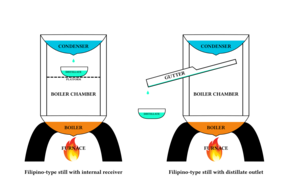Mezcal
Mezcal (/mɛˈskæl/ ⓘ, Latin American Spanish: [mesˈkal] ⓘ), sometimes spelled mescal, is a distilled alcoholic beverage made from any type of agave.
Native fermented drinks from maguey plant, such as pulque, existed before the arrival of the Spanish, but the origin of mezcal is tied to the introduction of Filipino-type stills to New Spain by Filipino migrants via the Manila galleons in the late 1500s and early 1600s.
[3] Pulque (a fermented drink from agave sap) is pre-colonial,[5][6] but the distillation of agave heart juice into mezcal was only introduced in the colonial era when Filipino sailors and migrants brought the technology of Filipino-type stills with them during the galleon trade between Mexico and the Philippines (1565 to 1815).
Mezcal is the product of the merging of pre-Columbian indigenous fermentation traditions and Asian distillation techniques brought over from the Philippines.
These were often substituted with larger capacity earthenware jars and bowls, bound wooden staves, or even metal cylinders.
The distillate is collected either by an internal container placed in between the two pans on a platform; or a spoon-shaped collector and gutter made from wood, rolled agave leaf, or carrizo cane (originally bamboo in the Philippines) that exits from the hollow log in between the pans to an external clay container.
Over the centuries that the Manila-Acapulco galleon trade was active, an estimated 75,000 Filipinos settled western Mexico and intermarried with indigenous and mixed-race families.
Although this wasn't complied with completely, the prohibition of vino de coco led to the expansion and commercialization of the production of mezcal to fill the local demand for cheap liquor.
The first mention of distilled agave spirits in colonial records is from 1619, by the Spanish cleric Domingo Lázaro de Arregui.
[6][11] The production of mezcal moved from the coastal river basins of the Río Grande de Santiago to the inland ravines by the early 1700s to evade the prohibition on indigenous spirits production, as well as to take advantage of the larger numbers of wild agave plants in the interiors.
[6] By the mid-1700s, the production of vino de coco had ceased completely due to the prohibition and the loss of coconut plantations.
[6] The small size of the Filipino-type stills made it easy to disassemble and move while evading colonial authorities.
The numerous well-like ancient graves cut into the rocks in the region were also coopted as fermentation basins for agave juice.
The technology was also transported through trade routes into Zacatecas, Guanajuato, Michoacán, Sonora, and the rest of Mexico, as well as parts of the southern United States, where modified Filipino-type stills have been reported.
They were hypothesized to have been capped with a condensing cold water-filled bowl, with a very small cup placed inside to collect the distillate.
Modern replicas using this method have been successful in producing small quantities of spirits with an alcohol content as high as 35%.
If the distillation of mezcal was indeed present in pre-Columbian Mexico, it would mean the introduction of Filipino-type stills merely expanded the production by using new techniques.
However, the archaeological evidence for this remains inconclusive,[15][11][20] as examination and molecular testing of ancient Capacha bules in 2019 have not detected any of the expected macroscopic botanical remains (like fibers) or chemical biomarkers for agave or any other high-sugar agricultural products (like fruits, cactus juice, honey, or corn) that could be distilled into spirits.
[21][22] There is also a Geographical Indication (GI), originally limited to the states of Oaxaca, Guerrero, Durango, San Luis Potosí, Puebla and Zacatecas.
However, Canadian laws also allow for local bottling and resale of imported mezcal, after its alcohol percentage has been adjusted with the addition of distilled or purified water.
[22] There is no exhaustive list, as the regulations allow any agaves, provided that they are not used as the primary material in other governmental Denominations of Origin.
[40][37] They are then crushed and mashed (traditionally by a stone wheel turned by a horse) and then left to ferment in large vats or barrels with water added.
[5] The mash is allowed to ferment, the resulting liquid collected and distilled in either clay or copper pots which will further modify the flavor of the final product.
[40] A special recipe for a specific mezcal type known as de pechuga is distilled with a chicken breast.
Other variations flavor the mash with cinnamon, pineapple slices, plátanos manzanos, and sugar, each imparting a particular character to the mezcal.
States that have certified mezcal agave growing areas with production facilities are Durango, Guanajuato, Guerrero, Oaxaca, San Luis Potosí, Puebla, Michoacan, Tamaulipas, and Zacatecas.
[43] In Tamaulipas, 11 municipalities have received authorization to produce authentic mezcal with the hopes of competing for a piece of both the Mexican national and international markets.
[44] Oaxaca produces 90% of the mezcal in Mexico, which presents a serious environmental threat to the state, according to local deputy Elena Cuevas Hernández.
[36][37] Mezcal is generally not mixed with any other liquids, but is often accompanied with sliced oranges, lemon or lime sprinkled with a mixture of ground fried larvae, ground chili peppers, and salt called sal de gusano, which literally translates as "worm salt".
[49][41] In the United States, a number of entrepreneurs have teamed up with Mexican producers to sell their products in the country, by promoting its handcrafted quality, as well as the Oaxacan culture strongly associated with it.











